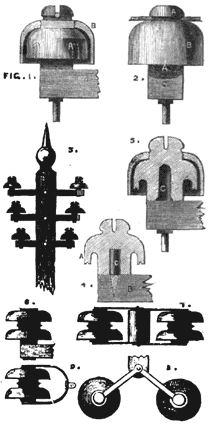[Trade Journal]
Publication: The Mechanics Magazine
London, England
vol. 1, p. 364-365, col. 2, 1
SIR CHARLES BRIGHT'S
PATENT INSULATORS FOR OVER-GROUND
TELEGRAPH WIRES.
SIR CHARLES T. BRIGHT has just completed a patent for improvement in insulators, and an improved mode of connecting insulators to posts and other supports. The following is his specification of the invention.
 |
"My invention consists in protecting insulators used to support over-ground wires by combining with the insulator a roof, or cover, composed of papier mache, wood, leather, iron, gutta-percha, or any mixture thereof, or any mixture thereof, or any suitable material which will act as a shield to, and protector for the insulator; by means of this cover, or protector, the degree of insulation afforded by the insulator is also augmented. Fig. 1 is a side view of a glass, or earthenware insulator A, with its cover, B B, shown in section. It is affixed to the insulator by screwing on a thread upon the neck of the latter. The spaces between the thread of the screw should be filled up with red lead, or any cement adapted to the materials of which the insulator and cover are made, and to the climate where they are used. Fig. 2 is an external view of the insulator A A, and cover B complete, affixed to an arm, C, by a bolt, a, fastened into the stem of the insulator by a cement composed of pitch, gutta-percha, red lead, and bees'-wax. At Fig. 3 is shown the mode of applying these insulators to the system of suspending over-ground wires described in the specification of a patent granted to Edward Brailsford Bright and myself the 21st day of October, 1852. My invention also consists in connecting the insulators to the posts, arms, or other supports, by means of a slightly elastic medium, by which the difficulties arising from the unyielding nature of the cement commonly used are obviated. Figures 4 and 5 show the manner in which I effect this part of my invention. In Fig. 4 the insulator A, shown in section, is attached to the arm B, by means of an iron pin, C, which is tightly sewed with well tarred yarn, upon which the insulator is then screwed down. At Fig. 5 the insulator is shown in section, and with a cover also in section, the form of connecting pin C is different. By increasing the size of the hole in the stem of the insulator, a wooden pin may be used with advantage in place of the iron pin; and it is obvious that many variations may be made in carrying out this part of my invention, both in the materials (as by the use of leather, felt, or other yielding substance around the pin), as well as in the form of the insulator, pin, or cover used. I also employ, where the curves are very sharp, or the strain very great from any other cause, the form of insulator shown at Fig. 6, which may be attached to the support by an upright pin passing through it, as there shown by the dotted lines a a. I prefer to place a piece of vulcanized India-rubber tubing round the pin. Or the insulators may be used in the manner represented in plan at Fig. 7, and in side view at Fig. 8. In this case the strain bears evenly upon the insulators at all times, and great facility is afforded for leading down wires on each side of the insulators for testing purposes, if the great weight at which the wires are erected, or other circumstances, render it desirable to do so.
"At Fig. 9 I show a convenient mode of employing this insulator for terminating line wires. The form of shackle shown was described in the specification of the patent to which I have before referred.
"A cover may he fitted to this insulator, and when it is used to break the continuity of the line wire (as for leading into a station) where it is not convenient to place a terminal pole, a weight may be fixed to the under side of the metal strap, in order to keep the roof, or cover, in its horizontal position."
